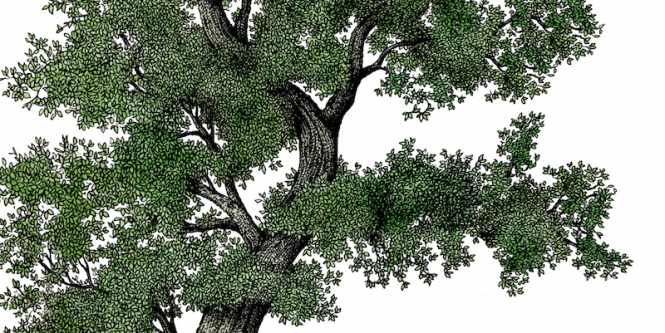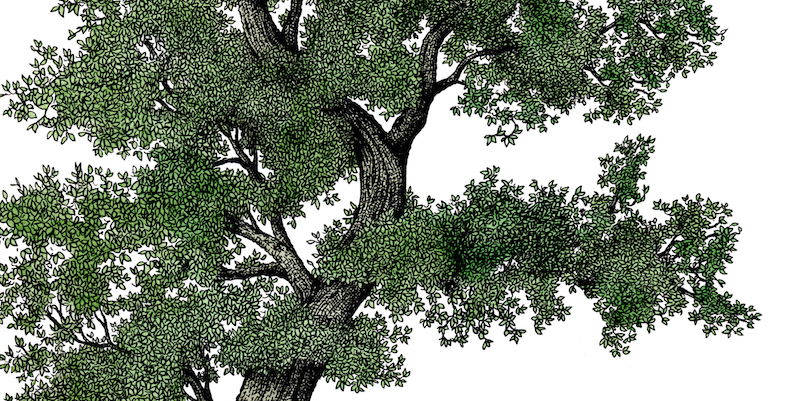

PC: https://lithub.com/
If you are wondering how to write an autobiography on a tree, then your search might end here. An autobiography of a tree can include the journey of a tree, how it was planted, and what nurtured a small plant to become a tree. Writing a tree autobiography can help kids to learn more about the trees in their surroundings. Besides, it also enables them to understand the process of making a small plant into a gigantic tree. Furthermore, an autobiography on a tree can engage kids in a fun way of learning. So, if you are into learning the process of tree autobiography then check it out!
Examples Of tree autobiography
Below are some examples of a tree autobiography so that kids can understand trees well and develop a better outlook towards their surrounding world:
1: Autobiography Of A Peepal Tree
I am a Peepal tree that grows near a temple in a village. I’ve been alive for so long that it’s difficult, if not impossible, for me to recall my exact and true age. In this peaceful little village, I have so many brothers and sisters. The majority of them are younger and smaller than I am. Banyan tree, Tamarind tree, and Jamun tree are their names. The lively chatting of the village ladies and the innocent giggles of the young children are two of my favourite things. Here, I never feel alone or lonely.
I was once a kid, what you humans call a vine, just like the children playing with marbles. I grew into a massive tree over time, with the aid of water and sunlight. I’m also aware of the reason for my being on this planet. I bear a heavy burden of duty to mankind. I supply fresh oxygen to all living organisms while simultaneously absorbing all harmful carbon dioxide gas. Photosynthesis is the name for this process.
Most trees, like humans, emit oxygen during the day and exhale carbon dioxide at night. That is not the case for me, though. Even at night, I expel plenty of fresh oxygen. My roots store a lot of water to keep the soil from eroding and flooding. I also provide shade to passers-by, tourists, and ordinary village residents. My brothers and sisters and I are also in charge of keeping the house cool.
As you read tree autobiography of peepal, let us tell you, it bring plenty of rain to the village and rejoice when the farmers reap a bountiful harvest. With the aid of my leaves, roots, bark, and other plant parts, I can also cure more than 50 diseases. My heart-shape leaves produce milk that people use to treat eye pain. I also help in curing other diseases like diarrhea, asthma, gastric problems, etc.
When people come to the temple to worship, they also worship me. They wrap a red thread around my trunk and circle me three times. They also light a small earthen lamp near my roots and pray for God to hear their prayers. In Hinduism, Buddhism, and Jainism, I am revered as a sacred tree. Lord Brahma is represented by my roots, Lord Vishnu is represented by my trunk, and my leaves represent Lord Shiva.
Vasudeva and the Chaitanya tree are some of the other names given to me. On Saturdays, a huge number of people come to water me. The explanation for this is that Lord Vishnu and his other half, Goddess Laxmi, are believed to reside in me every Saturday. While meditating under a Peepal tree, Gautam Buddha is said to have attained enlightenment. People worship me because they believe it will bring them happiness, good fortune, and a lot of money.
People spend almost the whole day around me, and I can listen to their stories and chit-chat. I learn about everything that goes on in the village, and sometimes even outside of it. You can see mothers cuddling their children and assisting them in taking a bath. I sometimes wish I were a person so that I could feel and experience what a mother’s love feels like. Thankfully, I have born in a place where people are so kind to each other and me.
I will continue to fulfil my destiny on this planet, just as God intended. However, I only have one proposal for all of you. Please recognise the significance of us, trees. Please don’t cut us carelessly. Plant more and more of us instead. And the day trees cease to exist on this earth, life ceases to exist.
If you want to teach kids about Peepal Tree then you should try this amazing tree autobiography.
2: Autobiography Of A Pine Tree
I am an old pine tree. I wasn’t planted by anyone with the seed from my neighbor. But, I just happened to grow all by myself. The role of nature is inevitable in my autobiography. There is a long line of us on the mountain. Fruits like cherries, berries, plums, and apricots would grow in the green exposure around me.
I take a lot of credit and fame for the joy I give to the people where I grow. Had I not been here along with my companions, this place would have been as bare as a desert. However, now the time has come when I have a great fear in my heart. We have seen many of us being cut down by the People who live here and also by builders who come from the big cities.
I do know that I will not die a natural death. I have to prepare myself for the pain that I have to suffer at the hands of those who chop us down. Each morning I pray to God to ask him to grant these humans some sense. I pray that they may let us live and make this earth a healthier and more beautiful space for us and them to live in.
Giving knowledge about trees’ importance is not easy, but you can do that by using this tree autobiography.
3: Autobiography Of A Mango Tree
Actually, as a small sapling, I was born alongside a lane. The rainy season was extremely beneficial to the sprouting of my crop. Someone must have thrown my seed, because it got buried in the soil and, thanks to the rains, even the sapling took root. I have to face many issues. Many insects bothered me, and the traffic on the roads buried me in dust.
On a beautiful day, a gardener happened to be driving down the lane. He took note of me and quickly realised I was a high-quality mango variety. Gardener carefully uprooted me and carried me to his house. He put me in an open field next to his house and watered me every day.
He also erected an iron fence around me to protect me from animals such as cows and goats. I started to mature quickly. I just grew in height and had very few leaves for the first few years. My stem looked like a child’s arm. It was really straight and thin. My stem began to grow wider and thicker after a few years. That was my teenage years; I was somewhere between a plant and a tree. But I still didn’t have any berries. My gardener was becoming increasingly frail. But he never strayed from his routine; he watered me every day, and after observing my progress, he realized I needed fertilizers. He treated me as his son because his son was born just a few days after he took me home.
With the gardener’s son, I have a lot of fond memories. In comparison to him, I grew faster. He treated me as a friend and even spoke to me. He told me what he was thinking about. I communicated with him using various signals. When I was upset with him, I would stop moving my leaves and stand still. I wave my leaves when I have a feeling of satisfaction. When I was down, I would lose a couple of them, and there were several more signals, but no one understood me better than he did.
Both of us continued to develop; I evolved into a fully grown tree, and he evolved from a young boy to a man. It was a lucky irony that the gardener’s son also had a son the first summer I bore fruit. Now, the gardener had died, and his son, as he told me, was a government officer. I’ve seen so many changes in the world around me, and I’ve transformed a simple mango tree into a tree of wisdom, which my fruits can pass on through their sweetness.
Mango and the richness in their taste is joyful but it is not the limit of this tree. You can teach your little kids more about it through this tree autobiography.
Final Words!
In this post, you learned how to write a tree autobiography with the help of the examples given here. I am sure you will try it out on your own. If this post has tickled you, then you may find more amazing posts in our blog section. Keep reading!
Frequently Ask Questions
Q1: What is an autobiography on a tree?
Ans: An autobiography on a tree is a unique literary work where the life story of a tree is narrated from its own perspective. It portrays the tree’s experiences, growth, challenges, and interactions with the environment throughout its life.
Q2: Why would a tree have an autobiography?
Ans: An autobiography on a tree serves as a creative way to explore the beauty of nature and the importance of trees in our ecosystem. It provides insights into the tree’s journey, highlighting its role in the environment and the valuable lessons we can learn from its resilience and wisdom.
Q3: What can we learn from an autobiography on a tree?
Ans: An autobiography on a tree offers valuable lessons about the interconnectedness of life, the cycles of nature, and the importance of adaptation and perseverance. It helps us appreciate the wonders of nature, foster environmental awareness, and understand the significance of trees in sustaining life on Earth.
Q4: Is an autobiography on a tree suitable for children?
Ans: Yes, an autobiography on a tree can be adapted to suit children’s understanding and engage their imagination. It can be an educational and entertaining way to introduce them to concepts such as nature, ecology, and the importance of environmental conservation.
Q5: Are there any real autobiographies written by trees?
Ans: While there may not be actual autobiographies written by trees, the concept of an autobiography on a tree is a creative and imaginative way to explore the world from a tree’s perspective. It allows us to reflect on the wonders of nature and the significance of trees in our lives.
